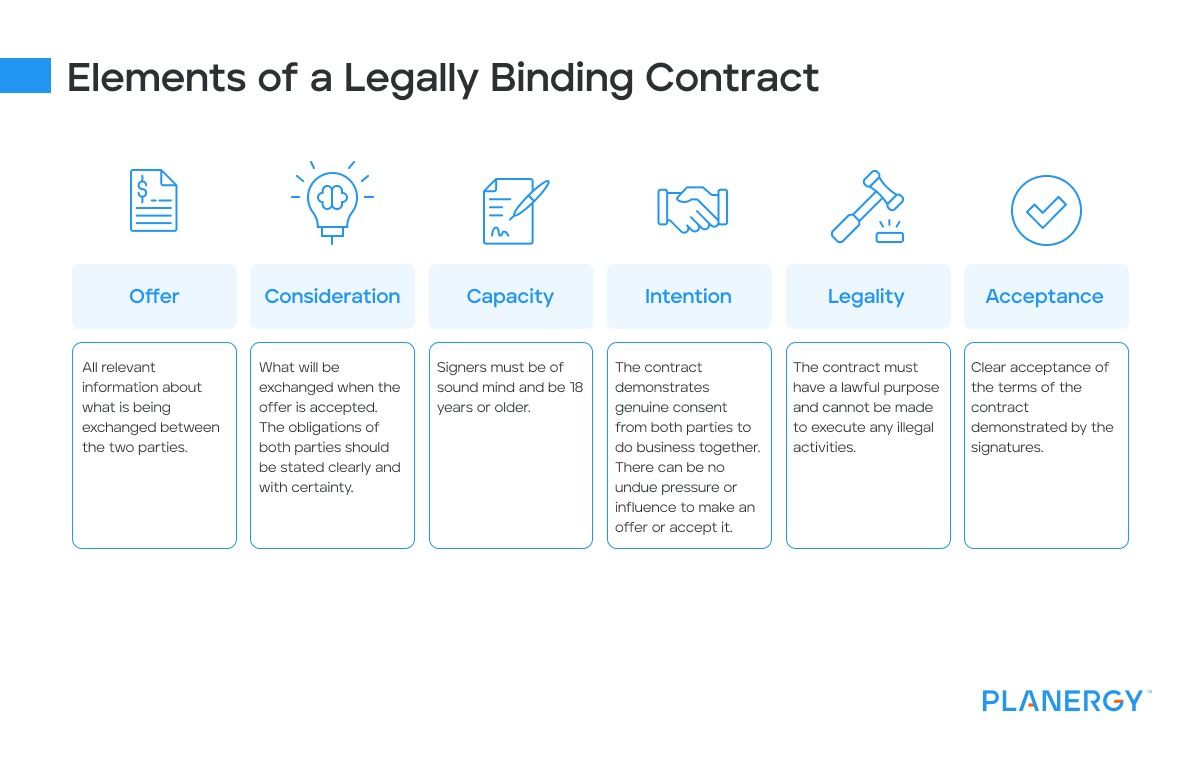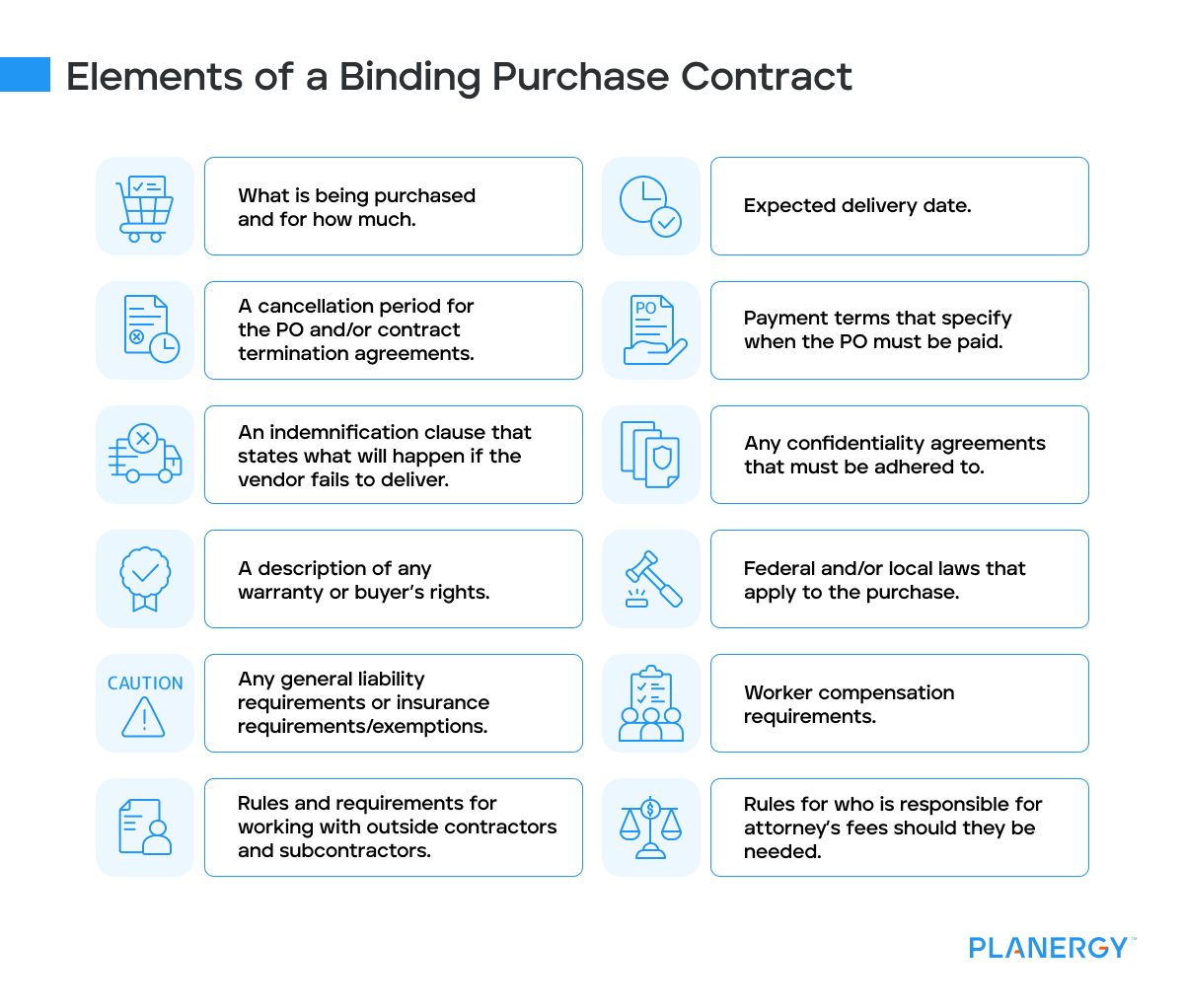A purchase order is a legally binding contract, however, it can exist alongside long-term procurement contracts between suppliers and customers without superseding them.
Purchase orders are designed to protect both parties. Sellers have legal recourse if they don’t get paid and buyers have legal recourse if they don’t get what they ordered.
This article will teach you about the legal agreements and protections that a purchase order provides and how you can best use them to benefit your business.
What Is a Purchase Order?
A purchase order (PO) is a document sent from a purchaser to a vendor when ordering goods or services. It serves as a legal agreement between the two parties that states what will be delivered and what will be paid for.
It only becomes a legally binding document once it’s accepted by the supplier. Suppliers have the right to reject a purchase order or ask for revisions.
POs include the name of the company making the purchase, a unique PO number, delivery date, address for an invoice, quantity, a description of goods and services being requested, pricing, payment terms, and any necessary payment information.
A PO is not the same thing as a long-term contract, but it does carry legal weight. Think of it more as a short-term contract for one individual purchase.
What Is a Contract?
A contract, in the procurement world, is a document shared between buyers and sellers that details the products or services sold, what prices they’re sold for, and the terms and conditions of the purchase. A contract is valid for a set period of time, often one year.
The main difference between a binding purchase contract and a purchase order is simply the duration of time.
A PO is legally binding for one order, while a contract is legally binding for a longer period. Contracts can be renewed after the given period with new pricing and terms.
Contracts typically guide purchase order creation, as the terms laid out in the contract dictate what should go on the PO.
If the price for an item is set in the contract for one year, then all POs should reflect that price for that year. The same goes for payment terms, delivery timelines, and anything else that the contract states.
The Difference Between a Contract and a Purchase Order
| Contract | Purchase Order |
|---|---|
● Long-term agreement ● Guides PO creation ● Can be renewed or renegotiated ● Pricing and terms set for contract time period | ● Agreement for a single purchase ● Is created based on contract terms ● Can be negotiated but only for a single purchase ● Pricing and terms set for just one purchase |

Is a Purchase Order a Binding Contract?
Purchase orders are legally binding contracts between purchasers and suppliers.
They provide the legal basis for buying and selling the goods or services described and provide protections for buyers and sellers.
A common misconception is that POs only serve recordkeeping purposes, but they can be used in a legal dispute.
However, POs are not a binding agreement until they are confirmed by the vendor.
Once the vendor accepts and signs the PO, it becomes a contract. If the vendor doesn’t want to accept the PO, they don’t have to. In that case, it isn’t legally binding.
The precedent for this was set by a federal court in Norfolk, Virginia, in the case of Mid Atlantic International Inc. v. AGC Flat Glass North America.
The dispute was over whether a certain specification for dolomite that the PO described was legally binding. The judge ruled that it was, and that purchase orders are an enforceable contract between the parties.
Once a PO is accepted by a vendor, they can potentially cancel it if they can come to agreeable terms with the buyer. However, if they try to cancel a PO that they are legally bound to, there can be legal consequences and litigation against them.
Purchase orders become a legal contract once they are accepted and signed by the vendor. If a vendor doesn’t want to accept a PO, they don’t have to, but once they do they are obligated to provide goods or services and the buyer is obligated to pay.
What Are the Elements of a Binding Purchase Contract?
Purchase orders lay out a specific legal agreement between buyers and sellers and become binding purchase contracts. Each PO has agreed-upon terms of the purchase for both parties to fulfill in all business transactions.
However, neither supplier nor purchaser can accept terms that require them to violate any governing industry regulations or laws where the contract will be executed.
The elements of any legally binding contract must include:
Offer
All relevant information about what is being exchanged between the two parties.
Consideration
What will be exchanged when the offer is accepted. The obligations of both parties should be stated clearly and with certainty.
Capacity
Signatures must be of sound mind and be 18 years or older.
Intention
The contract demonstrates genuine consent from both parties to do business together. There can be no undue pressure or influence to make an offer or accept it.
Legality
The contract must have a lawful purpose and cannot be made to execute any illegal activities.
Acceptance
Clear acceptance of the terms of the contract demonstrated by the signatures.

A binding purchase contract will generally include:
What is being purchased and for how much, i.e. product/service, price, and quantity.
An expected delivery date.
A cancellation period for the PO and/or contract termination agreements.
Payment terms that specify when the PO must be paid. A common example is net 30, which means payment will be made within 30 days. It can also specify penalties for non-payment within that time frame.
An indemnification clause that states what will happen if the vendor fails to deliver.
Any confidentiality agreements that must be adhered to.
A description of any warranty or buyer’s rights.
Federal and/or local laws that apply to the purchase.
Any general liability requirements or insurance requirements/exemptions.
Worker’s compensation requirements.
Rules and requirements for working with outside contractors and subcontractors.
Rules for who is responsible for attorney’s fees should they be needed.

Once the PO is accepted and agreed to by the vendor, all of these elements should be adhered to according to the purchase agreements detailed in the PO.
If either side violates any of these agreements, the other side has legal recourse based on the PO.
As a Legal Agreement, Does a Purchase Order Supersede a Contract?
Generally, a long-term contract that is agreed upon is considered to have more weight than a single PO.
Contracts clearly spell out the responsibilities of each party, including performance standards.
This reduces risk exposure for the buyer who is depending on a consistent supplier to support their business. However, it’s wise to use POs alongside the contract.
Some purchasing departments require POs for all purchases even when there is a contract in place, and will not pay unless there is a PO.
Using POs alongside contracts is favorable to the purchaser because it creates a paper trail and extra protection should things go wrong.
When there is a contract in place, it’s possible to end up with a PO that has no terms or cross references to the terms of the contract.
Contracts are preferred when the terms of the agreement are more intricate and detailed than just what’s covered on a PO. The more risk there is, the better it is to use both a contract and a PO.
The Best Way To Use POs As Binding Contracts
Using purchase order software makes it easy for you to ensure your purchase order process meets the legal agreements you need.
PLANERGY, for example, enables you to set automatically enforced rules that match your POs to the legal agreement in place with your supplier. The agreed price and master service agreement can be programmed into the purchase process.
Along with information about each vendor, you can store a copy of your contract and set rules to ensure compliance on the part of both parties. There is also a paper trail to ensure everything is in order.
From purchase requisition, purchases are automatically assigned a purchase requisition number.
Approved orders are automatically assigned a PO number. The system uses that number to match the PO and invoice, and ensure that terms are met.
An audit trail tracks all actions within the system to keep everyone accountable. PLANERGY also improves the business relationship by making it easier to pay invoices on time.
This also provides leverage for negotiating better payment terms and early payment discounts—which in turn helps you improve cash flow.
On top of helping you manage legal requirements, procurement software makes PO processes more efficient. This reduces time spent chasing down deliveries and minimizes back and forth communications with vendors.
You can also track supplier performance and make adjustments to your purchasing process as needed.
In the event that legal action takes place, PO software ensures that both parties have the legal documents to support their claim.
It’s a smart way for businesses to protect themselves while enjoying the benefits of a streamlined procurement team.




